Abstract
BALB/c mice injected with lyophilized vaccine from Streptococcus pneumoniae R36a (Pn) predominantly responded with antibody molecules the vast majority of which expressed the public idiotype T15 and were directed to the immunodominant epitope phosphorylcholine (PC). However, after a single immunization with Pn vaccine young (3-month-old) BALB/c mice did not produce any specific anti-T15 antibody response. In contrast, young D1.LP mice were able to mount a specific anti-T15 response upon primary immunization with pneumococcal vaccine. The anti-PC response in the two mouse strains differed in that the proportion of antibody molecules that expressed the T15 idiotype for Pn-primed D1.LP mice showed a smaller proportion of PC-specific antibody expressing the T15 idiotype. Neonatal injection of anti-T15 monoclonal antibodies led to a long-term suppression of the PC-specific T15+ B-cell clones but at young/adult age these mice maintained the ability to produce a normal amount of PC-specific antibody. Interestingly, the idiotypically-suppressed BALB/c mice mounted a significant anti-T15 response during the primary response to Pn. We interpreted these data as showing that the level of circulating idiotype may regulate the production of the complementary anti-idiotypic antibody. In addition, in vitro experiments demonstrated that the lack of the anti-T15 response during primary antibody response in BALB/c mice is probably because of a state of tolerance that is regulated by T cells.
Full text
PDF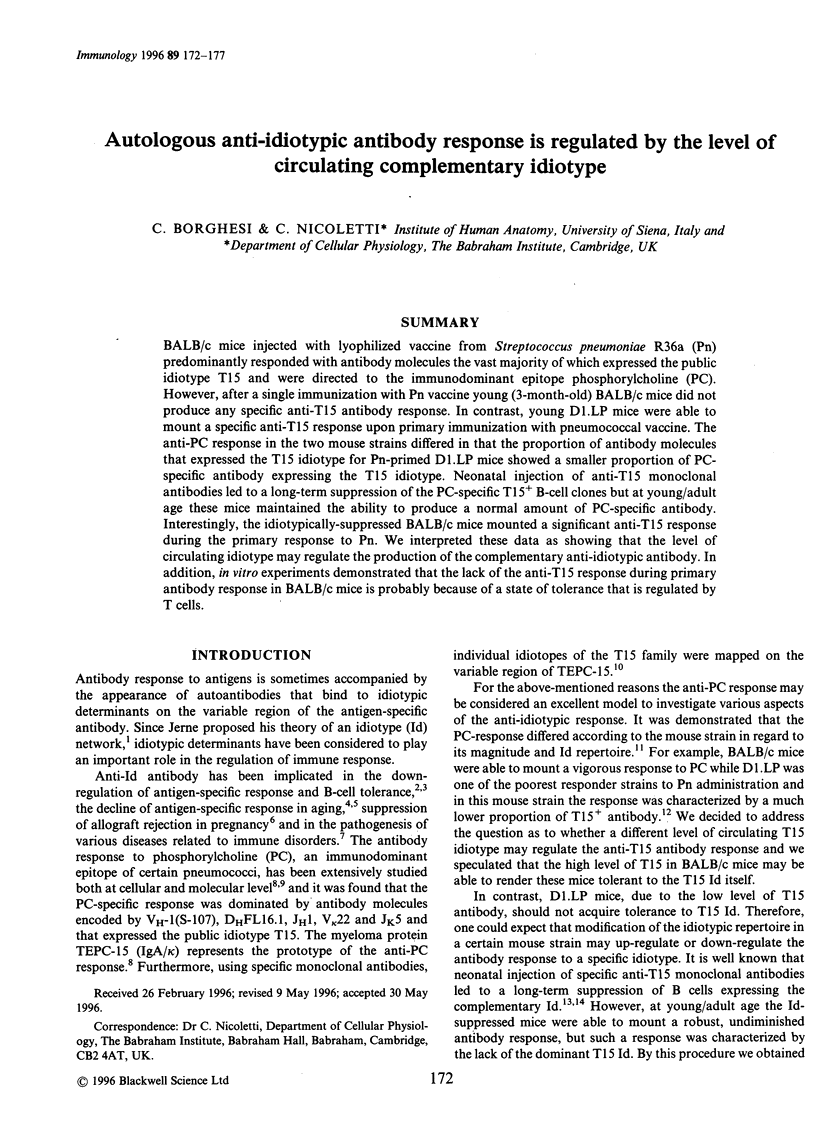
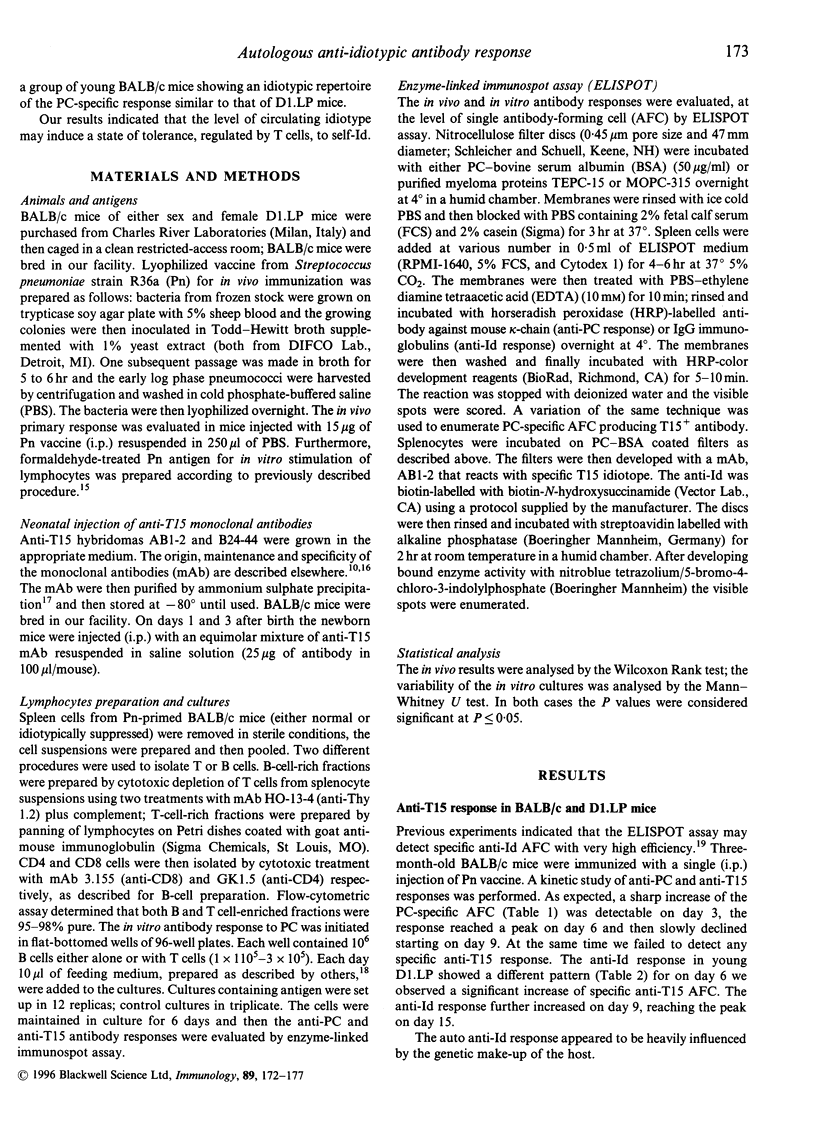
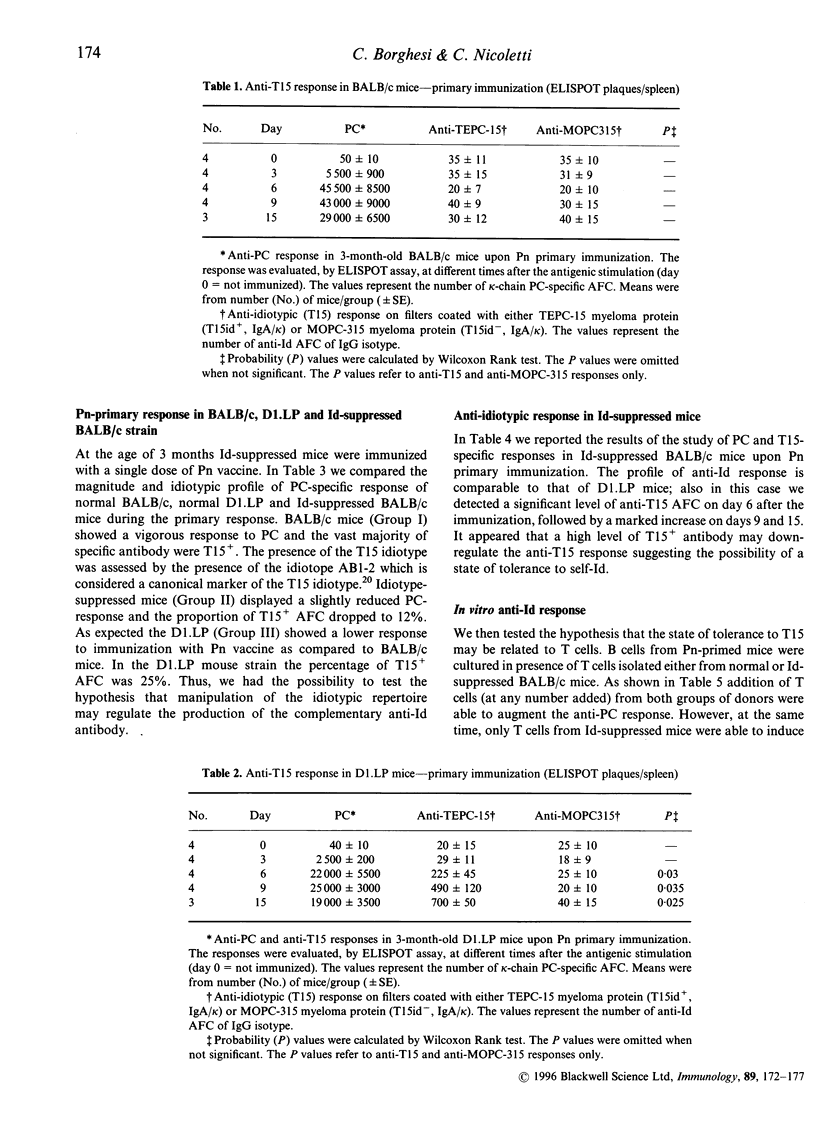
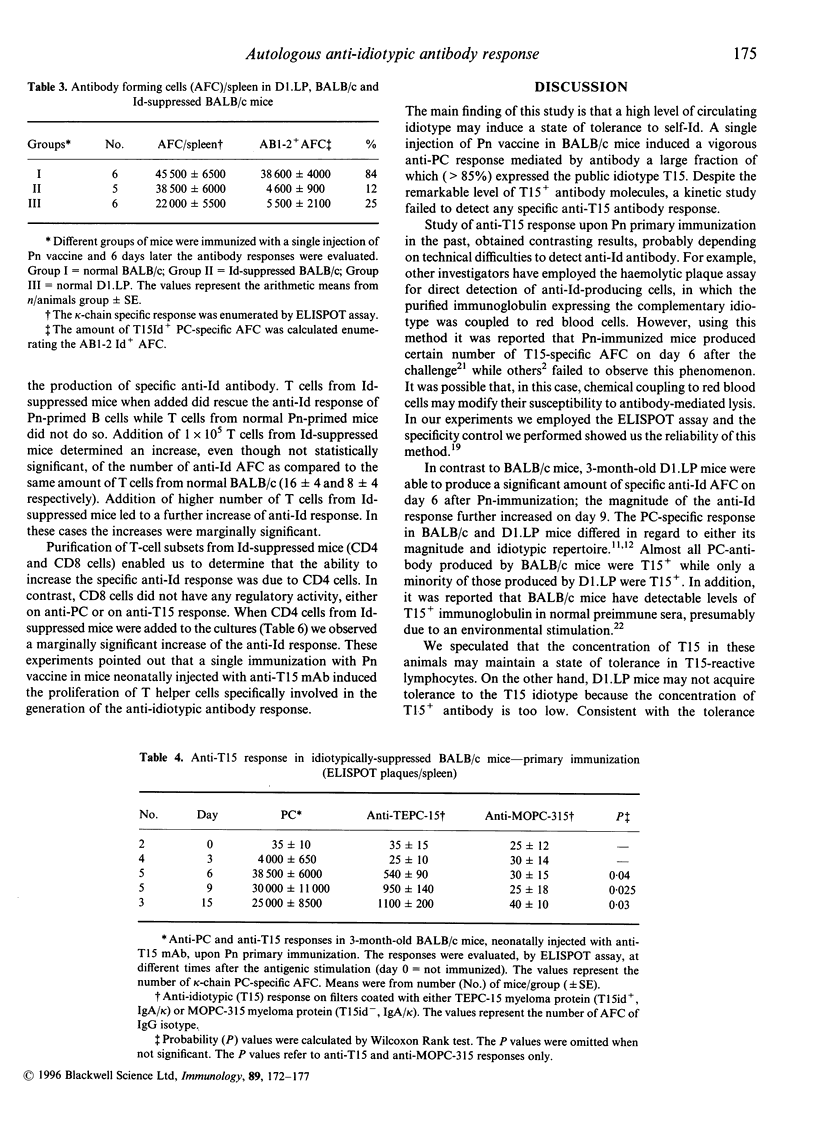
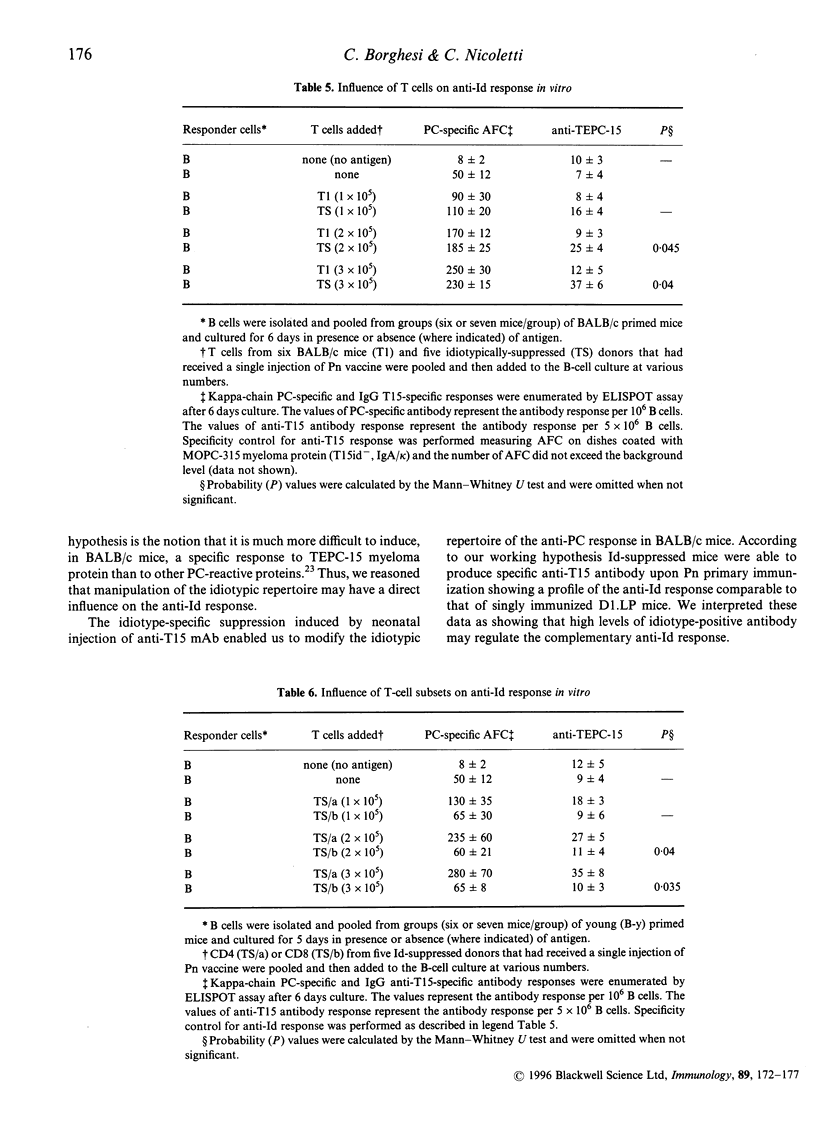
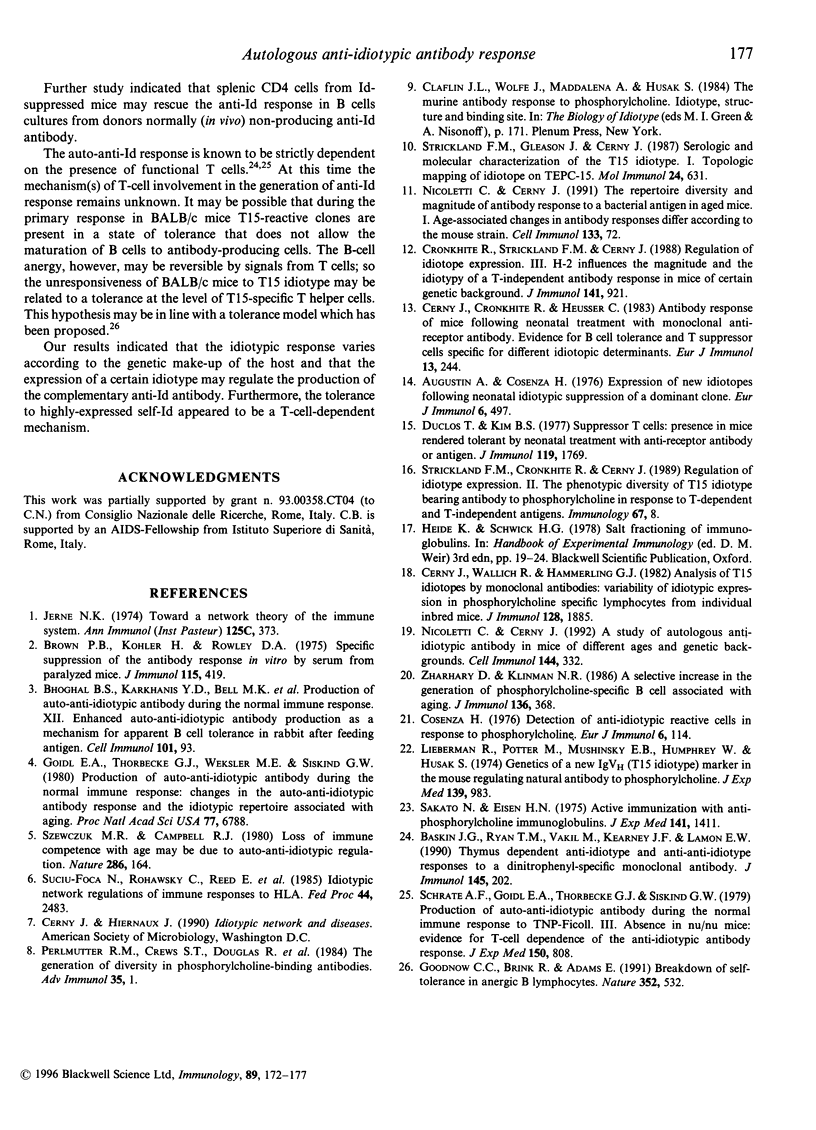
Selected References
These references are in PubMed. This may not be the complete list of references from this article.
- Augustin A., Cosenza H. Expression of new idiotypes following neonatal idiotypic suppression of a dominant clone. Eur J Immunol. 1976 Jul;6(7):497–501. doi: 10.1002/eji.1830060710. [DOI] [PubMed] [Google Scholar]
- Baskin J. G., Ryan T. M., Vakil M., Kearney J. F., Lamon E. W. Thymus-dependent antiidiotype and anti-antiidiotype responses to a dinitrophenyl-specific monoclonal antibody. J Immunol. 1990 Jul 1;145(1):202–208. [PubMed] [Google Scholar]
- Brown P. B., Köhler H., Rowley D. A. Specific suppression of the antibody response in vitro by serum from paralyzed mice. J Immunol. 1975 Aug;115(2):419–424. [PubMed] [Google Scholar]
- Cerny J., Cronkhite R., Heusser C. Antibody response of mice following neonatal treatment with a monoclonal anti-receptor antibody. Evidence for B cell tolerance and T suppressor cells specific for different idiotopic determinants. Eur J Immunol. 1983 Mar;13(3):244–248. doi: 10.1002/eji.1830130313. [DOI] [PubMed] [Google Scholar]
- Cerny J., Wallich R., Hammerling G. J. Analysis of T15 idiotopes by monoclonal antibodies: variability of idiotopic expression on phosphorylcholine-specific lymphocytes from individual inbred mice. J Immunol. 1982 Apr;128(4):1885–1891. [PubMed] [Google Scholar]
- Cosenza H. Detection of anti-idiotype reactive cells in the response to phosphorylcholine. Eur J Immunol. 1976 Feb;6(2):114–116. doi: 10.1002/eji.1830060208. [DOI] [PubMed] [Google Scholar]
- Cronkhite R., Strickland F., Cerny J. Regulation of idiotope expression. III. H-2 influences the magnitude and the idiotypy of a T-independent antibody response in mice of certain genetic backgrounds. J Immunol. 1988 Aug 1;141(3):921–925. [PubMed] [Google Scholar]
- Goidl E. A., Thorbecke G. J., Weksler M. E., Siskind G. W. Production of auto-anti-idiotypic antibody during the normal immune response: changes in the auto-anti-idiotypic antibody response and the idiotype repertoire associated with aging. Proc Natl Acad Sci U S A. 1980 Nov;77(11):6788–6792. doi: 10.1073/pnas.77.11.6788. [DOI] [PMC free article] [PubMed] [Google Scholar]
- Goodnow C. C., Brink R., Adams E. Breakdown of self-tolerance in anergic B lymphocytes. Nature. 1991 Aug 8;352(6335):532–536. doi: 10.1038/352532a0. [DOI] [PubMed] [Google Scholar]
- Jerne N. K. Towards a network theory of the immune system. Ann Immunol (Paris) 1974 Jan;125C(1-2):373–389. [PubMed] [Google Scholar]
- Lieberman R., Potter M., Mushinski E. B., Humphrey W., Jr, Rudikoff S. Genetics of a new IgVH (T15 idiotype) marker in the mouse regulating natural antibody to phosphorylcholine. J Exp Med. 1974 Apr 1;139(4):983–1001. doi: 10.1084/jem.139.4.983. [DOI] [PMC free article] [PubMed] [Google Scholar]
- Nicoletti C., Cerny J. A study of autologous anti-idiotypic antibody-forming cells in mice of different ages and genetic backgrounds. Cell Immunol. 1992 Oct 15;144(2):332–346. doi: 10.1016/0008-8749(92)90249-o. [DOI] [PubMed] [Google Scholar]
- Perlmutter R. M., Crews S. T., Douglas R., Sorensen G., Johnson N., Nivera N., Gearhart P. J., Hood L. The generation of diversity in phosphorylcholine-binding antibodies. Adv Immunol. 1984;35:1–37. doi: 10.1016/s0065-2776(08)60572-6. [DOI] [PubMed] [Google Scholar]
- Sakato N., Eisen H. N. Antibodies to idiotypes of isologous immunoglobulins. J Exp Med. 1975 Jun 1;141(6):1411–1426. doi: 10.1084/jem.141.6.1411. [DOI] [PMC free article] [PubMed] [Google Scholar]
- Schrater A. F., Goidl E. A., Thorbecke G. J., Siskind G. W. Production of auto-anti-idiotypic antibody during the normal immune response to TNP-ficoll. III. Absence in nu/nu mice: evidence for T-cell dependence of the anti-idiotypic-antibody response. J Exp Med. 1979 Oct 1;150(4):808–817. doi: 10.1084/jem.150.4.808. [DOI] [PMC free article] [PubMed] [Google Scholar]
- Strickland F. M., Cronkhite R. I., Cerny J. Regulation of idiotype expression. II. The phenotypic diversity of T15 idiotype-bearing antibody to phosphorylcholine in response to T-dependent and T-independent antigens. Immunology. 1989 May;67(1):8–15. [PMC free article] [PubMed] [Google Scholar]
- Strickland F. M., Gleason J. T., Cerny J. Serologic and molecular characterization of the T15 idiotype--I. Topologic mapping of idiotopes on TEPC15. Mol Immunol. 1987 Jun;24(6):631–635. doi: 10.1016/0161-5890(87)90044-7. [DOI] [PubMed] [Google Scholar]
- Suciu-Foca N., Rohowsky-Kochan C., Reed E., Haars R., Bonagura V., King D. W., Reemstma K. Idiotypic network regulations of immune responses to HLA. Fed Proc. 1985 May;44(8):2483–2487. [PubMed] [Google Scholar]
- Szewczuk M. R., Campbell R. J. Loss of immune competence with age may be due to auto-anti-idiotypic antibody regulation. Nature. 1980 Jul 10;286(5769):164–166. doi: 10.1038/286164a0. [DOI] [PubMed] [Google Scholar]
- Zharhary D., Klinman N. R. A selective increase in the generation of phosphorylcholine-specific B cells associated with aging. J Immunol. 1986 Jan;136(2):368–370. [PubMed] [Google Scholar]


